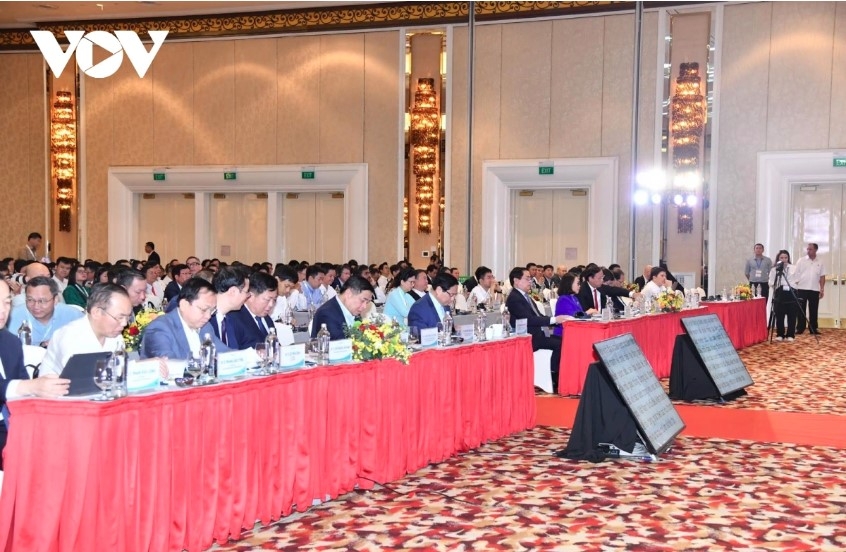
To develop logistics infrastructure, the Vietnamese Government leader suggested a number of solutions from airport-related projects and emphasized strengthening public-private cooperation, promoting integration and innovation for sustainable development, following world trends such as digital, green, and sustainable development.
PM Chinh pointed out 3 goals and 7 tasks for logistics development, emphasizing efforts to achieve double-digit growth in the coming year. It is essential to reduce logistics costs in the country's GDP from 18% to 15% in 2025; increase the scale of logistics in GDP from 10% to 15%, striving to reach 20%; raise the scale of Vietnam's logistics in the world's logistics scale from 0.4% to 0.5%, striving to reach 0.6%; and increase the growth rate of the logistics industry from 14-15% towards 20%.
In his speech, Minister of Industry and Trade Nguyen Hong Dien emphasized that logistics is viewed as a service industry that is considered the "blood vessels" of the economy, playing an important role in connecting and supporting businesses and production facilities to reduce costs, reduce product prices, improve competitiveness, and boost socio-economic development.
Vietnam is located in a dynamic development region of the world, where the flow of goods is concentrated and the economy is highly open (over 200%), with 17 free trade agreements (FTAs) signed and implemented with nearly 70 countries and territories (including most of the world's major economies, accounting for 90% of global GDP).
With import-export turnover and e-commerce always growing at double digits, Vietnam is considered one of the markets with great potential and conditions for developing logistics services.
In recent times, the Vietnamese Party and State have issued many mechanisms, policies and directed the effective implementation of solutions to remove difficulties, reduce costs, improve competitiveness, and create a favorable environment for the development of the logistics service industry.
In 2024, Vietnam was evaluated and ranked by international organizations in the Top 10 emerging logistics markets; Top 4 in the world in the Logistics Opportunity Index and Top 43 in the Logistics Performance Index.
In addition to the achieved results, the development of Vietnam's logistics service industry has not been commensurate with the country's potential and advantages amid still high logistics costs and low competitiveness.
Furthermore, the shortage of human resources, especially high-quality human resources and lack of infrastructure connectivity are major "bottlenecks" that have hindered the development of logistics services in recent times.
With its strategic and potential geographical location, strengths in developing deep-water seaport infrastructure, international airports, road and railway traffic hubs with countries in the region and the world, Vietnam has all the favorable conditions to build and develop large-scale and modern free trade zones.
The Ministry of Industry and Trade, as the focal point for state management of logistics services, is submitting to the Prime Minister a draft strategy for the development of Vietnam's logistics services for the 2025 - 2035 period, with a vision to 2050.
Accordingly, the draft strategy has proposed many synchronous and drastic solutions to realize the goal of making Vietnam a strong country in logistics, actively contributing to the cause of national industrialization and modernization.
The Viet Nam Logistics Business Association (VLA) reported that the growth rate of the logistics industry in Vietnam in recent years has reached about 14% - 16%, with a scale of about US$40 - 42 billion per year.
According to the World Bank's rankings, Vietnam currently ranks 43rd out of 155 countries in logistics efficiency and is among the top 5 ASEAN member states after Singapore, Malaysia, Thailand and the same rank as the Philippines.
With an annual growth rate of 14 - 16%, this is one of the fastest and most stable growing service industries in Vietnam in recent times.
In 2023, Vietnam's import-export turnover hit US$ 681 billion, equal to 158% of the country's GDP.

According to the latest forecast by Standard Chartered, Vietnam will be one of the key contributors to global trade growth with export turnover expected to reach US$618 billion by 2030, with an annual growth rate of 7%.
Import turnover by 2030 is projected to hit US$578 billion, up by an average of 6.9% per year. Currently, Vietnam is assessed to have many opportunities to spur the development of the logistics service industry with road traffic infrastructure, airports, seaports, warehouses, commercial infrastructure, and logistics centers constantly being expanded on a large and widespread scale.
In addition, accompanying services have been promptly meeting the extremely diverse requirements of the market, while procedures and customs clearance times for exports have also improved significantly.
In particular, there has been a recent boom in e-commerce and logistics for e-commerce.
The size of Vietnam's retail e-commerce market reached US$20.5 billion, an increase of about US$4 billion, equivalent to 25% compared to 2022.


